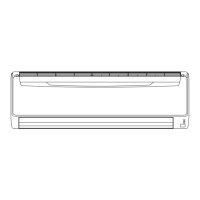What to do if my Fujitsu AOYR14LGC has an indoor fan lock error?
- AAndrea JosephSep 12, 2025
If your Fujitsu Air Conditioner is displaying an indoor fan lock error, check the fan motor connector for looseness or defective contact.

What to do if my Fujitsu AOYR14LGC has an indoor fan lock error?
If your Fujitsu Air Conditioner is displaying an indoor fan lock error, check the fan motor connector for looseness or defective contact.
What to do if my Fujitsu AOYR14LGC Air Conditioner has an indoor fan speed error?
If your Fujitsu Air Conditioner is showing an indoor fan speed error, check the fan motor connector for looseness or defective contact.
| Refrigerant | R32 |
|---|---|
| Weight (Indoor Unit) | 9.5 kg |
| Type | Split System |
| Power Supply | 50 Hz |
| Noise Level (Outdoor) | 50 dB |
Details electrical specifications like capacity, power source, current, and input watts.
Lists fan motor speeds and airflow modes for different operation modes.
Provides noise level data for indoor and outdoor units across various fan speeds.
Specifies the gross and net weight for indoor and outdoor units.
Details compressor type, refrigerant type, pipe length, and full charge.
Provides detailed measurements (H x W x D) for indoor and outdoor units.
Illustrates the refrigerant flow and specifies pipe diameters for different models.
Shows the electrical connections and component layout for indoor and outdoor units.
Explains how cooling capacity is controlled based on room and outdoor temperatures.
Details heating capacity control based on room and outdoor temperatures.
Describes compressor and fan control during dry mode operation.
Explains fan speed settings and operation logic for indoor fan.
Details compressor operation frequency ranges and start-up control.
Outlines conditions for starting and completing defrost operations.
Covers protections like discharge gas temperature, current release, and anti-freezing.
Lists specialized tools required for R410A refrigerant handling.
Advises on pipe selection, flare nuts, and avoiding contamination for R410A.
Highlights differences and precautions for servicing R410A compared to R22.
Explains HFC refrigerants and phase-out schedules.
Compares R410A with R22 regarding oil, pressure, and material requirements.
Troubleshooting steps for when the unit shows no signs of operation.
Explains how to use the self-diagnosis feature and interpret error codes.
Guides on diagnosing and resolving serial communication errors between units.
Provides troubleshooting steps for IPM protection faults in the outdoor unit.
Offers a table for diagnosing refrigerant cycle issues and component failures.
Details how to set various operational functions via the remote control.
Explains jumper settings for outdoor unit preheating functions.
Provides graphs showing pressure and current vs. temperature data.
Lists resistance and voltage values for various thermistors.
Presents performance data (capacity, input) under different operating conditions.
Illustrates replaceable parts for the indoor unit.
Shows diagrams of replaceable components for the outdoor unit.
Specifies wiring, circuit breaker, and power supply requirements.
Guides on choosing optimal indoor and outdoor unit installation locations.
Details the process for mounting the indoor unit and connecting pipes.
Covers placement and installation procedures for the outdoor unit.
Explains how to remove air from the refrigerant circuit.
Describes refrigerant recovery procedures for relocation or disposal.











